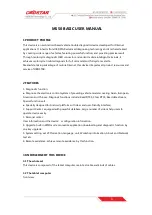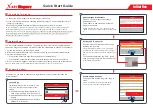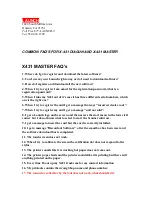
18
WARNING: Suction tubes for insertion in the human body purchased separately from the machine
should comply with ISO 10993-1 standards on material biocompatibility.
Aspiration jar: The mechanical resistance of the component is guaranteed up to 30 cycles of cleaning and
sterilization. Beyond this limit, the physical-chemical characteristics of the plastic material may show signs of
decay. Therefore, we recommend that you to change it.
Silicone tubes: the number of cycles of sterilization and/or cleaning is strictly linked to the employment of the
said tube. Therefore, after each cleaning cycle, it is up to the final user to verify whether the tube is suitable
for reuse. The component must be replaced if there are visible signs of decay of the material constituting the
said component.
Conical fitting: the number of cycles of sterilization and the number of cleaning cycles is strictly linked to
the employment of the said component. Therefore, after each cleaning cycle, it is up to the final user to verify
whether the fitting is suitable for reuse.
The component must be replaced if there are visible signs of decay in the material constituting the said
component.
Service life of the device: More than 1000 hours of operation (or 3 years) in accordance with the standard
conditions of testing and operation. Shelf life: maximum 5 years from the date of manufacture.
CLEANING OF ACCESSORIES
Before using the device, the manufacturer advises you to clean and/or sterilize the accessories.
Washing and / or cleaning the autoclavable jar as to be carried out as follows:
• Wear protection gloves and apron (glasses and face mask if necessary) to avoid contact with contaminat-
ing substances;
• Disconnect the tank from the device and remove the said container from the support of the device.
• Separate all the parts of the cover (overflow device, washer).
• Disconnect all tubes from the jar and the protection filter
• Wash each part of the container from secretions under cold running water and then clean every single part
in hot water (temperature not exceeding 60°C)
• Once again, carefully wash each single part using, if necessary, a non-abrasive brush to remove any deposits.
Rinse with hot running water and dry all parts with a soft cloth (non-abrasive). It is possible to wash with com-
mercial disinfectants by carefully following the instructions and dilution values supplied by the manufacturer.
After cleaning, leave the parts to dry in an open, clean environment.
• Dispose of the aspiration catheter according to that provided by local laws and regulations.
The silicone aspiration tubes and the conical fitting may be carefully washed in hot water (temperature must
not exceed 60°C). After cleaning, leave the parts to dry in an open, clean environment.
When cleaning is complete, reassemble the container for liquid aspirations according to the following procedure:
• Place the overflow valve into its seat in the cover (under VACUUM connector)
• Insert floating valve keeping the o-ring towards the opening of the cage
• Place the o-ring into its seat around the cover
• After completing assembling operations always make sue that cover seals perfectly to avoid vacuum leack-
ages or liquid exit
The jar and the cover can be autoclaved by placing the parts into the autoclave and running one sterilization
stem cycle at 121°C (1 bar relative pressure – 15 min) making sure that the jar is positioned upsidedown.
Mechanical resistance of the jar is guaranteed up to 30 cycles of sterilization and cleaning at the indicated
conditions (EN ISO 10079-1). Beyond this limit the physical-mechanical characteristics of the plastic may
decrease and replacement of the part is therefore recommended.
After sterilization and cooling at environment temperature of the parts make sure that these are not damaged.
The aspiration tubes can be sterilized on autoclave using a sterilization cycle at 121°C (1 bar relative pres-
sure – 15 min).
The conical connector can be sterilized on autoclave using a sterilization cycle at 121°C (1 bar relative pres-
sure – 15 min).
ENGLISH































